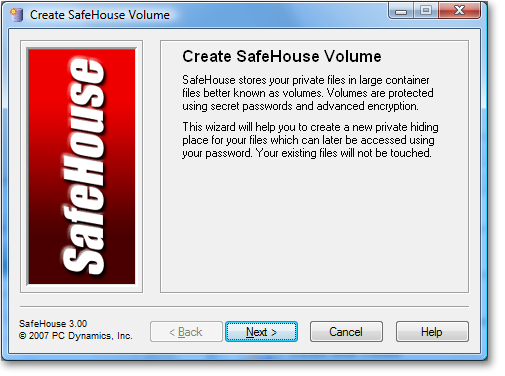![]() The Create
SafeHouse Volume wizard is used to create the container files which
will house your private files being protected by SafeHouse.
The Create
SafeHouse Volume wizard is used to create the container files which
will house your private files being protected by SafeHouse.
This wizard will walk you through steps of picking a name, location, size and password.
SafeHouse keeps your confidential files in large protected container files which can range in size from a few megabytes to hundreds of gigabytes. In a way, they're sort of like folders.
 Some people like to refer to these special files as safes
or data vaults, because each one is protected using a password known only
to you. In SafeHouse, we call these files "volumes", which is
simply a fancy term which has gained popularity over time for describing
this kind of technology.
Some people like to refer to these special files as safes
or data vaults, because each one is protected using a password known only
to you. In SafeHouse, we call these files "volumes", which is
simply a fancy term which has gained popularity over time for describing
this kind of technology.
Once you move your files into one of these containers, they're instantly under the full protection of SafeHouse. SafeHouse only guards files which are contained in volumes.
SafeHouse volumes can hold as many files in them as will fit. And if you do ever run out of room, you can easily make your volumes bigger. You likely created your first volume when you installed the software; however, there's really no limit to the number of volumes you can create.
SafeHouse typically keeps your volumes in one common folder to make them easier to work with. This folder is named C:\SafeHouse.
Volumes can be located nearly anywhere, including:
Internal and external hard drives
USB Flash disks and memory sticks
Network servers
Volumes on CD/DVD: SafeHouse volumes cannot be created directly on CD/R and DVD/R devices, but can be read from them as read-only storage vaults.

Start SafeHouse Explorer.
Click the New Volume toolbar button or Create New SafeHouse Volume item from the Tools menu.

This wizard will advance through the following series of pages:
More on SafeHouse Volumes |
Here's a few things you should know about SafeHouse volumes:
Volumes are standard Windows files. You can view, move or delete them in Explorer just as you would with any other kind of file.
The file extension for SafeHouse volumes is .SDSK. You can easily identify them by their distinctive red folder icon (shown above) .
The maximum size for a volume is 2,000 Gigabytes, or the size of your hard drive; whichever is less.
You can create as many volumes as you wish.
Volumes can be located on internal and external hard drives, USB drives, memory sticks, CDs, DVDs and network servers.
Every volume has a password. Passwords can be changed as often as desired.
Volumes can be securely backed up to other drives, tape or DVDs using standard backup software.
Windows will treat your volumes as new "virtual" hard drives which are only accessible once you enter your password.
Volumes support all drag-and-drop file operations in Windows Explorer.
When your files are saved inside a volume, they are protected using super-strong encryption.
When you move a file out of a volume, it is no longer protected by SafeHouse.
SafeHouse Professional Edition offers a number of extra features for creating new volumes. This includes greater control of resizing properties, stronger encryption methods and support for resetting lost passwords.
If SafeHouse Explorer detects that SafeHouse Professional Edition is installed on the same PC, it will automatically use the enhanced version of the Create New Volume wizard which is included with that software. You will therefore automatically receive the benefit of any of these advanced features.